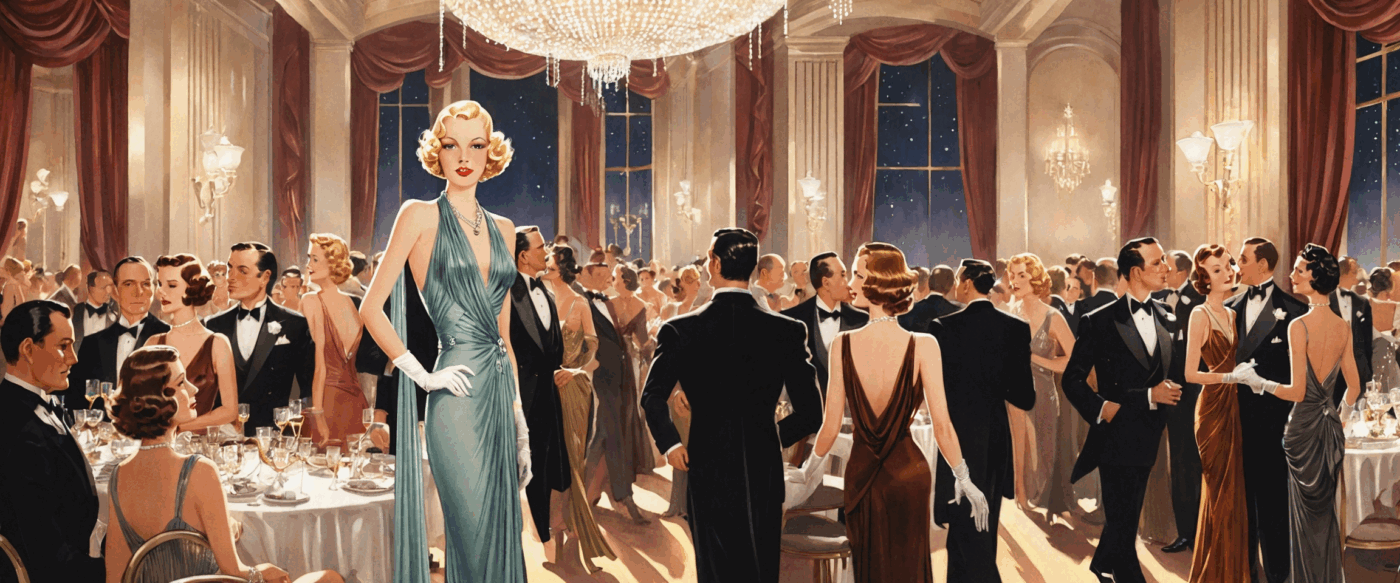The 1930s: when fabric started to move
After the crisp, straight lines of the flapper era, the new decade asked fashion to flow. The stock‑market crash had sobered society, but women (and movie studios) still wanted escapism. Designers answered with gowns cut on the bias—a 45‑degree angle to the grain that lets cloth stretch, spiral and cling—creating silhouettes that felt both modern and antique, like Greek marble suddenly alive.
Who mastered the bias?
| Designer | Signature | Why they mattered |
|---|---|---|
| Madeleine Vionnet | Silk satin, spiral seams, no corsetry | Refined the full‑garment bias cut and patented her patterns. Her mannequins stood on a lazy‑Susan so she could sculpt in the round. |
| Alix (Madame Grès) | Draped silk jersey “goddess” gowns | Used live models and countless hand‑tucks to mould fabric into rippling columns. |
| Gilbert Adrian (MGM, Hollywood) | Liquid satin for Jean Harlow; sculpted shoulders for Joan Crawford | Cinema turned his bias gowns into mass desire; fans mailed the studio begging to buy them. |
| Elsa Schiaparelli & Jeanne Lanvin | Surrealist prints; romantic eveningwear | Adopted bias foundations, then embellished with trompe‑l’œil bows, mirrors and embroidery. |
Where were these dresses worn?
- Silver‑screen sets & premieres – Harlow’s ivory satin in Dinner at Eight (1933) or Garbo’s languid gowns broadcast the look worldwide.
- Glamorous nightspots – New York’s Stork Club, London’s Embassy or the Côte d’Azur casino circuit demanded slinky silhouettes that shimmered under artificial light. Art‑Deco mirrored interiors amplified every swish.
- Ocean‑liner decks & Riviera resorts – Bias‑cut “goddess” day dresses in washable rayon packed small but looked expensive, perfect for Depression‑era leisure travel.
- Ballrooms & society weddings – Satins in pale champagne or pastel ice‑blue replaced stiff brocade, letting brides and debutantes move freely during foxtrots.
What changed because of the bias cut?
- A new ideal of the body
Cling without corsetry celebrated natural curves yet demanded posture—today’s slip dress owes its DNA to this revelation. - Technical revolution in pattern‑making
Cutting diagonally wastes fabric but unlocks stretch; textbooks still teach Vionnet’s angled panels and “spiral” seam equations. - Hollywood as a fashion engine
With Paris struggling under economic strain, movies exported trends; Adrian’s gowns for Crawford birthed the broad‑shouldered 1940s silhouette that followed. - Recurring revivals
1970s: Halston’s ultrasuede dresses; 1990s: John Galliano’s bias slip for Dior and his own label, worn by Kate Moss and Princess Diana, reignited the look for a grunge‑meets‑glamour era. - From couture to ready‑to‑wear
Affordable rayons and, later, synthetics allowed mass‑market brands to imitate couture drapes—helping democratise luxury during the Depression and beyond.
Legacy in your wardrobe today
If you’ve ever slipped on a silky cami dress, knotted a sarong that hugs just right, or admired a jersey gown that moves like water, you’re wearing an idea first perfected in the 1930s. The bias cut wasn’t merely a technique; it was a philosophy that fabric should live on the body – and that elegance can be effortless even in hard times.

